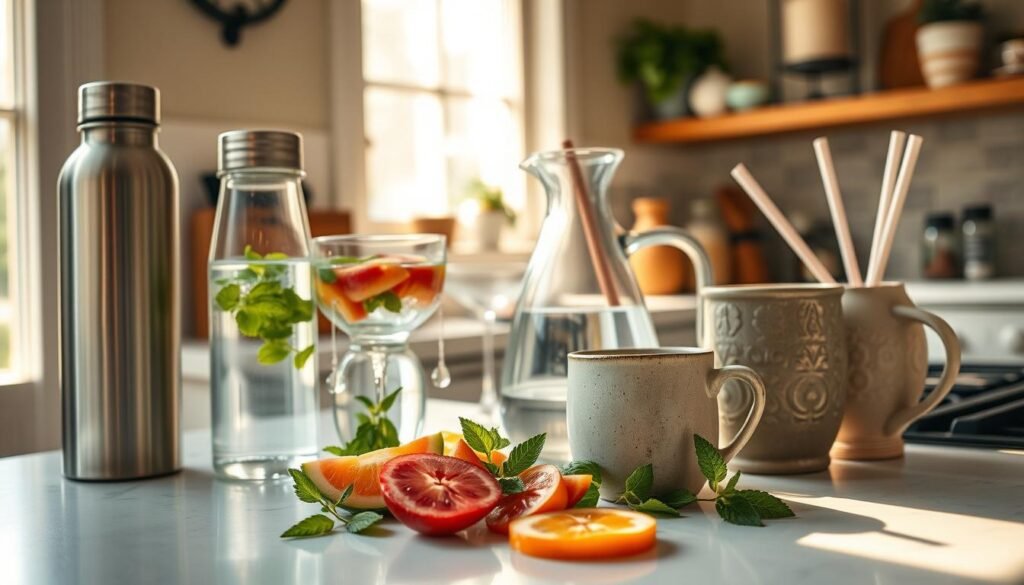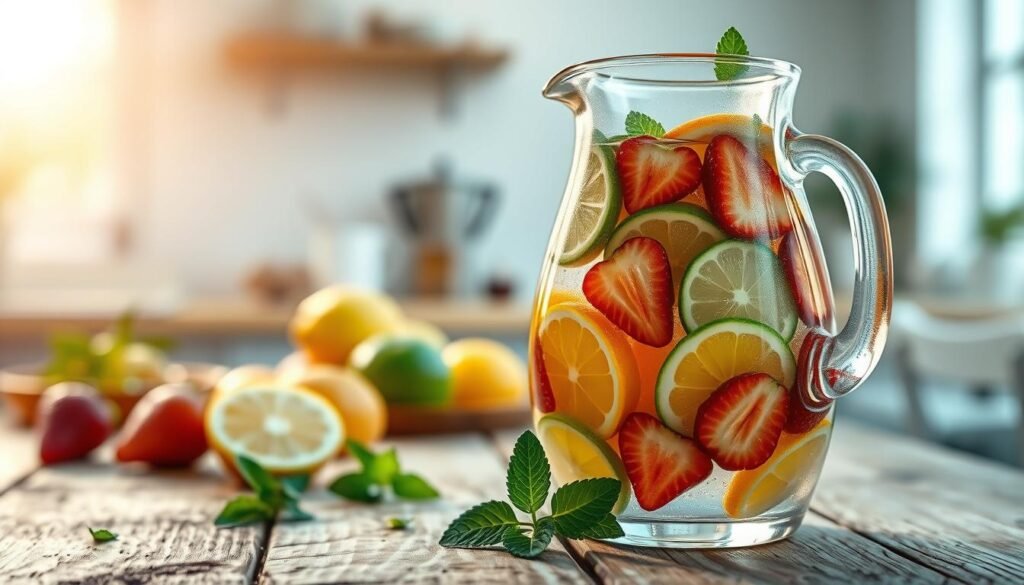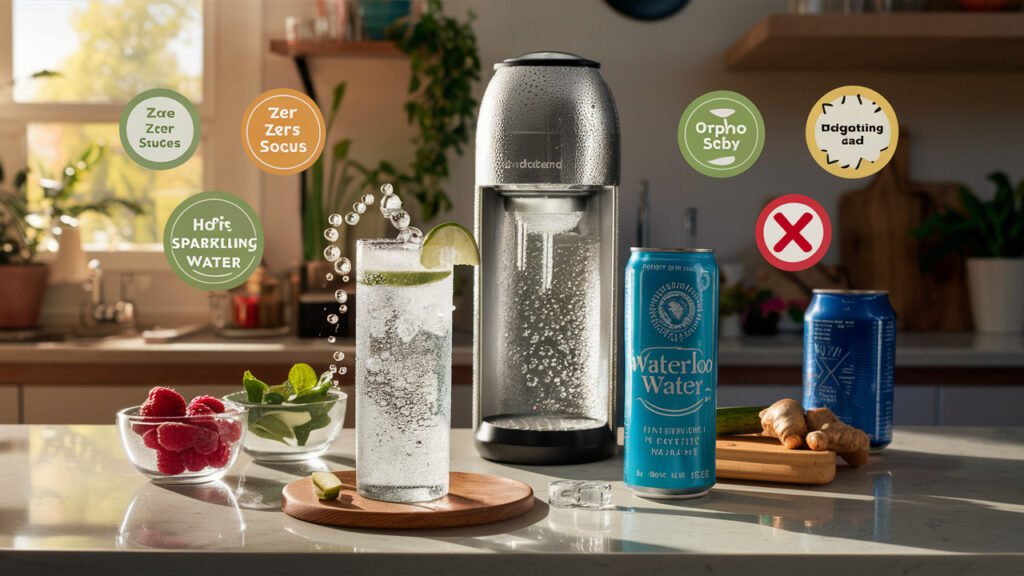Are You Struggling to Stay Hydrated Because You Can’t Stand the Taste of Water?
You’re not alone; many adults find it challenging to meet their daily water intake due to its bland taste. Despite knowing that proper hydration is crucial for overall health and wellbeing, the struggle is real.
The good news is that there are simple and effective ways to make water more palatable without adding excessive calories or artificial ingredients. By implementing a few small changes in how you consume water, you can significantly improve your hydration levels.
This article will guide you through practical strategies to transform drinking water from a chore into an enjoyable part of your daily routine.
Key Takeaways
- Discover simple methods to make water more enjoyable to drink.
- Learn how to improve your hydration without forcing yourself.
- Understand the importance of proper hydration for your overall health.
- Explore ways to incorporate more water into your daily routine.
- Find out how small changes can make a significant difference in your hydration goals.
Why Staying Hydrated Matters
Water is fundamental to numerous bodily functions, making hydration key to good health. Your body is comprised of about 70% water, which is vital for maintaining various physiological processes.
The Role of Water in Your Body
Water plays a crucial role in regulating body temperature, lubricating joints, and facilitating the transport of nutrients and oxygen to cells. It also supports organ function and helps remove waste products.
Signs You’re Not Drinking Enough
Failing to drink enough water can lead to dehydration, characterized by symptoms such as dark urine, dry mouth, fatigue, headaches, and dizziness. Chronic mild dehydration can escalate into more serious health issues over time, impacting energy levels, cognitive function, and physical performance.
Understanding Your Daily Fluid Needs
Your body’s fluid needs are influenced by various factors, making a personalized approach necessary. The National Academy of Medicine (NAM) provides general guidelines for daily fluid intake.
How Much Water Should You Actually Drink?
The NAM recommends that men consume about 125 ounces (3,700 ml) and women about 90 ounces (2,700 ml) of fluid per day. This includes fluid from water, other drinks, and foods. It’s essential to note that the “8 glasses a day” rule is an oversimplification and not based on scientific evidence.
Factors That Affect Your Hydration Requirements
Individual fluid needs vary based on factors such as body weight, activity level, climate, and overall health. For instance, exercise, hot weather, illness, pregnancy, and breastfeeding can significantly increase fluid requirements. Monitoring urine color is a practical way to gauge hydration status, as it should be pale yellow. Additionally, it’s worth noting that thirst is not always a reliable indicator, especially for older adults whose thirst sensation may be diminished.

- Activity level: More fluid is needed for those who are physically active.
- Climate: Hot and humid environments increase fluid requirements.
- Health status: Certain medical conditions and pregnancy/breastfeeding can affect fluid needs.
By understanding these factors, you can better assess your individual fluid needs and maintain proper hydration.
10 Ways to Drink More Water (If You Hate the Taste)
If you’re struggling to drink more water because you dislike the taste, you’re not alone. Many people find plain water bland and unappealing, making it difficult to consume enough throughout the day.
Why Plain Water Can Be Unappealing
The taste of tap water can vary significantly based on local water treatment and mineral content. Some common reasons for disliking plain water include its lack of flavor, temperature issues, and potential mineral tastes. Understanding these factors can help you find a solution.

How These Methods Can Transform Your Hydration Habits
By making small, enjoyable modifications to your water intake, you can significantly increase your consumption. The following 10 methods are designed to make hydration habits more pleasurable without adding excessive calories or artificial ingredients. Experimenting with these ways to enhance the taste of water can help transform drinking water from a chore into an enjoyable habit.
- Exploring different temperatures and flavors
- Infusing water with fruits or herbs
- Using sparkling or carbonated water
By trying out these methods, you can discover a drink water routine that works best for you.
Add Natural Flavors with Fruits
Using fruits to flavor your water is a simple and effective way to stay hydrated. Adding fresh fruits to your water not only enhances the taste but also provides a naturally flavored beverage without added sugars or artificial ingredients.
Best Fruits for Water Infusion
The best fruits for water infusion include citrus fruits like lemon, lime, and orange, as well as berries such as strawberries, raspberries, and blueberries. Other options like cucumber, watermelon, and pineapple are also great choices.
Some popular fruit combinations to use in an infuser bottle are cucumber-lime, lemon, and strawberry-kiwi. You can experiment with different combinations to find the one that suits your taste.
| Fruit | Flavor Profile | Infusion Time |
|---|---|---|
| Lemon | Citrusy, refreshing | 30 minutes |
| Strawberry | Sweet, fruity | 1-2 hours |
| Cucumber | Mild, refreshing | 30 minutes to 1 hour |
How to Create Fruit-Infused Water at Home
Creating fruit-infused water at home is easy. Simply slice your chosen fruits and add them to a pitcher or a specialized fruit infuser bottle. Let it infuse in the refrigerator for at least 30 minutes to allow the flavors to meld.
You can make larger batches to have flavorful water available throughout the day. Using an inexpensive fruit-infuser water bottle is one healthy option, as it allows you to enjoy the benefits of infused water without added sugars or artificial ingredients.
For more ideas on healthy drinks, you can check out 5 superfood smoothie recipes to boost your metabolism.

Experiment with Herbs and Botanicals
Discover a world of flavors by infusing your water with herbs and botanicals. These natural ingredients not only add unique flavors but also provide aromatic qualities that can elevate your hydration experience.
Refreshing Herb Combinations
Popular herbs like mint, basil, rosemary, thyme, and lavender can be used to create refreshing and complex flavor profiles in your water. For example, combining mint with citrus fruit slices or pairing rosemary with lemon can create a delightful taste experience.
- Mint and citrus for a refreshing twist
- Basil and strawberries for a sweet and savory mix
- Rosemary and lemon for a herbaceous and tangy flavor
Creating Your Signature Herb-Infused Water
To create your own signature blend, start by selecting a few herbs and gently bruising their leaves to release their flavor. Then, combine them with water and let it infuse in the refrigerator. You can grow many of these herbs at home, even in small spaces, providing a fresh and economical source for your infusions.
Experiment with different combinations to find your favorite way to enjoy herb-infused water.
Try Sparkling or Carbonated Water
For those who find plain water unappealing, sparkling or carbonated water can be a refreshing alternative. Adding bubbles to your water can transform your hydration experience by introducing a pleasing texture and sensation without adding calories.
A study published in The American Journal of Clinical Nutrition found that fizzy water is just as hydrating as still water, dispelling common myths about its effectiveness. The effervescence of carbonated water can make it more satisfying and enjoyable for many people, encouraging them to drink more throughout the day.

Benefits of Bubbles for Reluctant Water Drinkers
The carbonation process can make water more appealing to those who struggle with its plain taste. With various flavors available, from limoncello to apple cider, you can choose a sparkling water that suits your taste preferences.
- Carbonation adds texture and sensation to water without calories.
- Sparkling water is equally hydrating as still water.
- The effervescence can make water more enjoyable to drink.
Options from Store-Bought to Home Carbonation
You have a wide range of options when it comes to carbonated drinks. You can choose from naturally carbonated mineral waters, which offer additional minerals, or artificially carbonated varieties. Store-bought sparkling waters come in numerous flavors, but you can also consider home carbonation systems as a cost-effective and environmentally friendly way to enjoy your favorite water at home.
Use Temperature to Your Advantage
The temperature at which you drink water can greatly impact your hydration experience. Adjusting the temperature can make water more enjoyable, thus encouraging you to drink more throughout the day.
Why Cold Water May Be More Appealing
Cold water is often preferred because it can be more refreshing, especially during hot weather or after exercise. Research has shown that cold water suppresses taste bud sensitivity, which may prevent you from tasting impurities or unpleasant tastes in the water.
Filling your glass with your favorite kind of ice — whether crushed or cubed — can make a significant difference. The refreshing chilliness of cold water can make it more enjoyable to drink.
Enhancing Flavor with Ice Cubes
One creative way to enhance the flavor of your water is by using flavored ice cubes. You can make these by adding cut fruit (like lemon, lime, and orange slices) to ice cube trays filled with water. As the ice cubes melt, they infuse your water with a refreshing flavor.
Other ideas for flavored ice cubes include freezing juice, coffee, or tea. Herb-infused ice cubes are another option, offering a subtle flavor that can enhance your drinking experience. Experimenting with different flavors can help you find the perfect taste to keep you hydrated.
| Ice Cube Flavor | Description | Taste Experience |
|---|---|---|
| Fruit Infused | Made with fruits like lemon, lime, or orange | Refreshing and fruity |
| Coffee or Tea | Freezing brewed coffee or tea into ice cubes | Caffeine boost with a subtle flavor |
| Herbal Infusions | Using herbs like mint or basil | Subtle and refreshing herbal taste |
As noted by a study, the temperature of water can affect its taste. Cold water can mask mineral tastes that some people find unpleasant. This makes it a simple yet effective way to make water more enjoyable to drink.
“Cold water suppresses taste bud sensitivity, which may prevent you from tasting impurities.”
Incorporate Tea and Herbal Infusions
For those who find plain water unappealing, tea offers a flavorful alternative that still provides excellent hydration. Like sparkling water, tea is every bit as hydrating as regular water and can add a whole new world of charisma to your cup.
Hydrating Benefits of Unsweetened Teas
Unsweetened tea counts toward your daily fluid intake and provides hydration equivalent to water. It has zero calories and often packs antioxidants, depending on the variety. You can choose from a wide variety of tea options, from traditional black and green teas to herbal infusions like chamomile, rooibos, and hibiscus.
Hot vs. Cold Tea Options
Both hot and cold teas offer unique sensory experiences and practical applications. Cold-brew tea can provide a smoother, less bitter flavor profile. When choosing a tea, be mindful of the caffeine content to avoid jitteriness from excessive intake. You can enjoy tea at different times of the day, making it a versatile drink option.
Upgrade Your Water Quality
You can transform your hydration experience by paying attention to the quality of your water. Tap water, although safe in many areas, can contain impurities that affect its taste and safety. Upgrading your water quality can be achieved through filtration, making a significant difference in your drinking experience.
How Filtration Can Improve Taste
Filtration can remove impurities and substances that create unpleasant flavors in tap water, such as chlorine, minerals, and organic compounds. By using a water filter, you can enjoy cleaner and fresher-tasting water. Activated carbon filters are particularly effective at removing chlorine and improving the overall taste.
Choosing the Right Water Filter for Your Needs
Selecting the right water filter depends on your local water quality, budget, and specific concerns. Options range from simple pitcher filters to under-sink systems and whole-house filtration. Consider the types of contaminants you want to remove and choose a filter that addresses those needs. Regular filter replacement is also crucial for maintaining optimal performance and water quality.
Create a Hydration Routine and Track Progress
Developing a consistent hydration routine is crucial for making drinking water a sustainable habit. By incorporating hydration into your daily schedule, you can ensure you’re drinking enough water throughout the day.
Setting SMART Water-Drinking Goals
To effectively create a hydration routine, setting SMART (Specific, Measurable, Attainable, Realistic, Time-bound) goals is essential. For example, aiming to drink 32 ounces (960 ml) of water per day is a SMART goal. This approach helps in creating achievable targets.
- Specify your daily water intake goal.
- Measure your progress using a water bottle or tracking app.
- Ensure your goal is attainable based on your activity level and climate.
Apps and Tools to Monitor Your Intake
Utilizing apps and physical tools can significantly enhance your hydration tracking. Popular hydration tracking apps offer features like reminders, progress visualization, and goal setting. Additionally, physical tools such as marked water bottles with time indicators can help you stay on track.
By combining a well-structured hydration routine with effective tracking tools, you can develop sustainable hydration habits.
Conclusion: Making Hydration a Sustainable Habit
Now that you’ve discovered the top 10 ways to make water more enjoyable, it’s time to make hydration a sustainable habit. By incorporating these simple yet effective methods, you can transform your relationship with water and stay hydrated with ease.
You’ve learned how to add natural flavors with fruits, experiment with herbs and botanicals, try sparkling water, and more. The key is to find what works best for you and make it a part of your daily routine.
Start with one or two methods and be patient with yourself as you develop new hydration habits. Remember, small, consistent changes can lead to significant health improvements over time. View hydration as an act of self-care, and you’ll be drinking water like a pro in no time.
FAQ
How can I make plain water more flavorful?
What are some signs that I’m not drinking enough water?
How much water should I drink daily?
Can I meet my hydration needs with other beverages besides water?
How can I track my water intake effectively?
Is sparkling water a good alternative to plain water?
Can certain foods help contribute to my daily hydration needs?
How does temperature affect the taste of water?
editor's pick
latest video
news via inbox
Nulla turp dis cursus. Integer liberos euismod pretium faucibua




